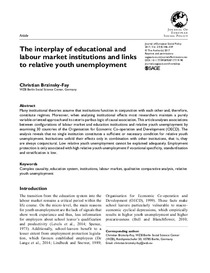The interplay of educational and labour market institutions and links to relative youth unemployment

Journal of European Social Policy
2017
27
4
Oct.
346-359
educational system ; labour market ; youth unemployment
Education and training
https://doi.org/10.1177/0958928717719198
English
Bibliogr.
" Many institutional theories assume that institutions function in conjunction with each other and, therefore, constitute regimes. Moreover, when analysing institutional effects most researchers maintain a purely variable-oriented approach and its ceteris-paribus logic of causal association. This article analyses associations between configurations of labour market and education institutions and relative youth unemployment by examining 30 countries of the Organisation for Economic Co-operation and Development (OECD). The analysis reveals that no single institution constitutes a sufficient or necessary condition for relative youth unemployment. Institutions unfold their effects only in combination with other institutions, that is, they are always conjunctural. Low relative youth unemployment cannot be explained adequately. Employment protection is only associated with high relative youth unemployment if vocational specificity, standardisation and stratification is low."
Digital
The ETUI is co-funded by the European Union. Views and opinions expressed are however those of the author(s) only and do not necessarily reflect those of the European Union or the ETUI.